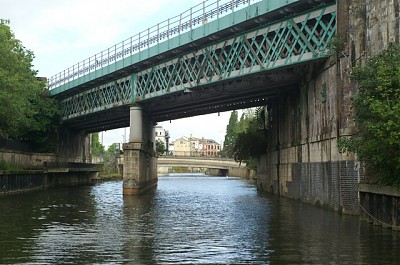Skew Railway Bridge
|
|
||||
 |
||||
| Bridge Name: | Skew Railway Bridge | |||
| No.: | 196 | |||
| Location: | ||||
| Build Date: | ||||
| Engineer: | John Cambridge | |||
|
© Copyright Pierre Terre and licensed for reuse under this Creative Commons Licence. |
||||
| Description: | ||||
| Mr John Cambridge, was passed away on Tuesday [12th March 1918] at 10, Lower Oldfield Park, Bath, for close upon 50 years was a valued official of the G.W.R. Company. He was a native of Gloucester, and entered the railway service when a young man. It was in the [eighteen] seventies he came to Bath as permanent way inspector, and soon afterwards was promoted to Inspector of Bridges for the Bath district, covering a large and important area. His great achievement was rebuilding the present (sic) Skew Bridge over the Avon near the Bath Station, and so skilfully did he manage this that traffic on the main line was not stopped for the operations.
When he laid his proposal before the Board at Paddington it seemed so unlikely that a director suggested that Mr Cambridge was mad. “Give me the materials and the men”, replied that gentleman, “and it shall be done.” And done it was, Mr Cambridge receiving the special thanks of the chief officials of the line for his wonderful work. The original wooden bridge, built under the supervision of a master shipwright, was considered a great success, as the structure being so much on the skew the ribs had to be much wider in their span than had they crossed the river at a right angle. The iron bridge was built up between the ribs of the wooden bridge. Great piles had to be driven for the formation of the stage, from which the material of the new erection were lifted. The eight girders, each weighing 36 tons, arrived by water in sections of 18 tons each, and were raised by hydraulic power; the sections were riveted together and lifted by the same process close up under the floor of the old bridge. The girders were supported by their outer ends resting on solid brick work built upon the masonry, on which the older ribs rested, while the inner ends bore on four iron columns, weighing six tons each. On the brick work at each side was placed a stone course, many of the stones weighing three tons apiece, and on this stone, at the points where the girders took their bearing, were placed iron shoes. As the girders were fixed the new deck was formed by cutting out, one at a time, the old baulks of wood, and replacing them with old railway metals. The total weight of the material used in the bridge was over 500 tons. No wonder that Mr Cambridge, as supervising engineer, was proud of the structure. He was also responsible for the large railway bridge at Stratton, near Dorchester; another at Holt, Trowbridge, Wilts, and many other important structures carrying the railway. When the Westmoreland Arch was widened Mr. Cambridge made the drawings and superintended the operations; he was also responsible for the big retaining wall erected opposite Stothert and Pitt’s works when the Lower Bristol Road was widened. After leaving the G.W.R. Company’s staff he was given the supervision of building the new Midland Bridge, which the Tramway Company provided for the city, and also the removal and reconstruction of the old bridge at the Destructor yard. Mr Cambridge likewise acted as clerk of works under the City Waterworks Engineer at Batheaston reservoirs. From an article in the Bath Cronicle dated March 13th 1918 |
||||
| References: | ||||
